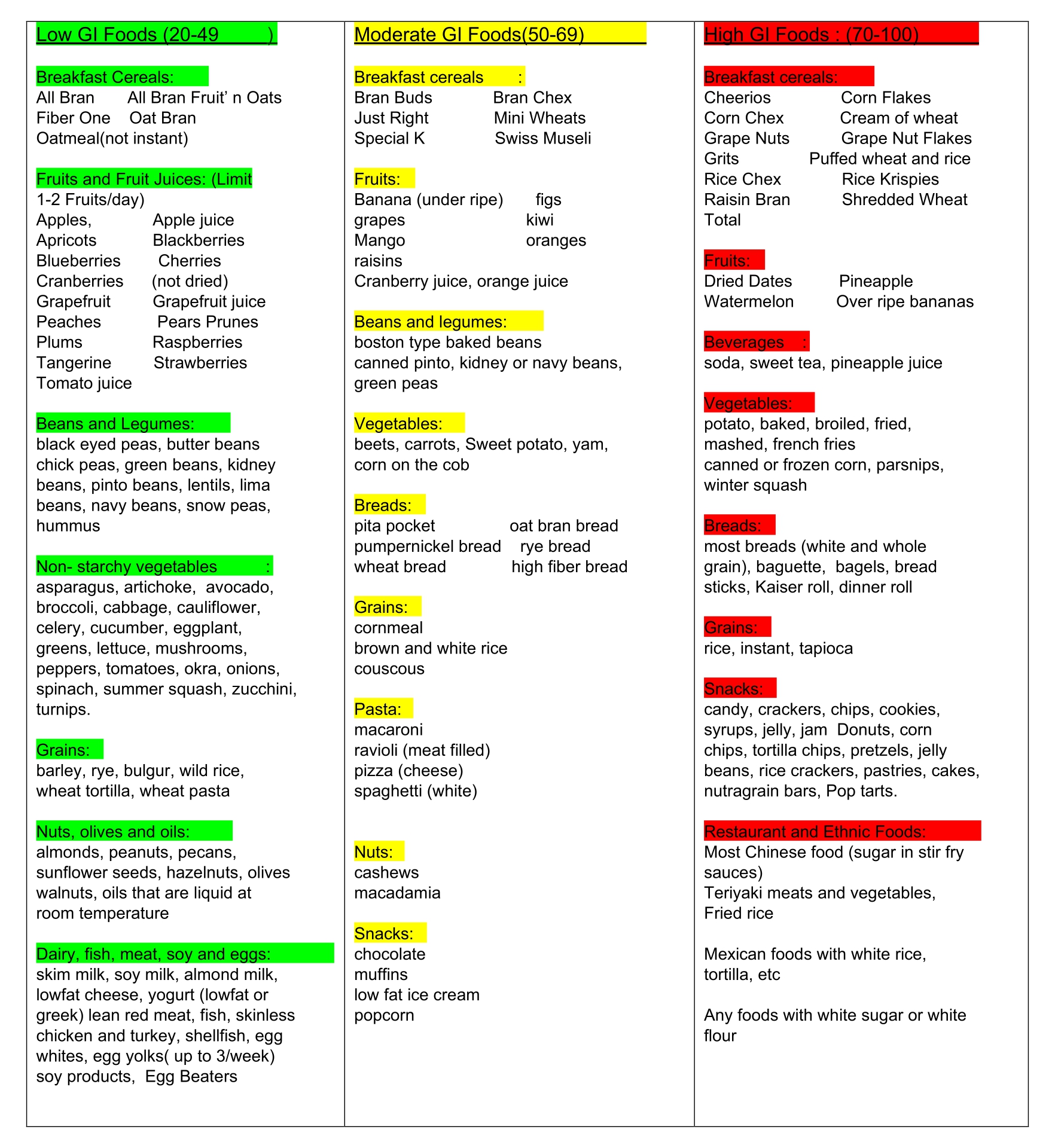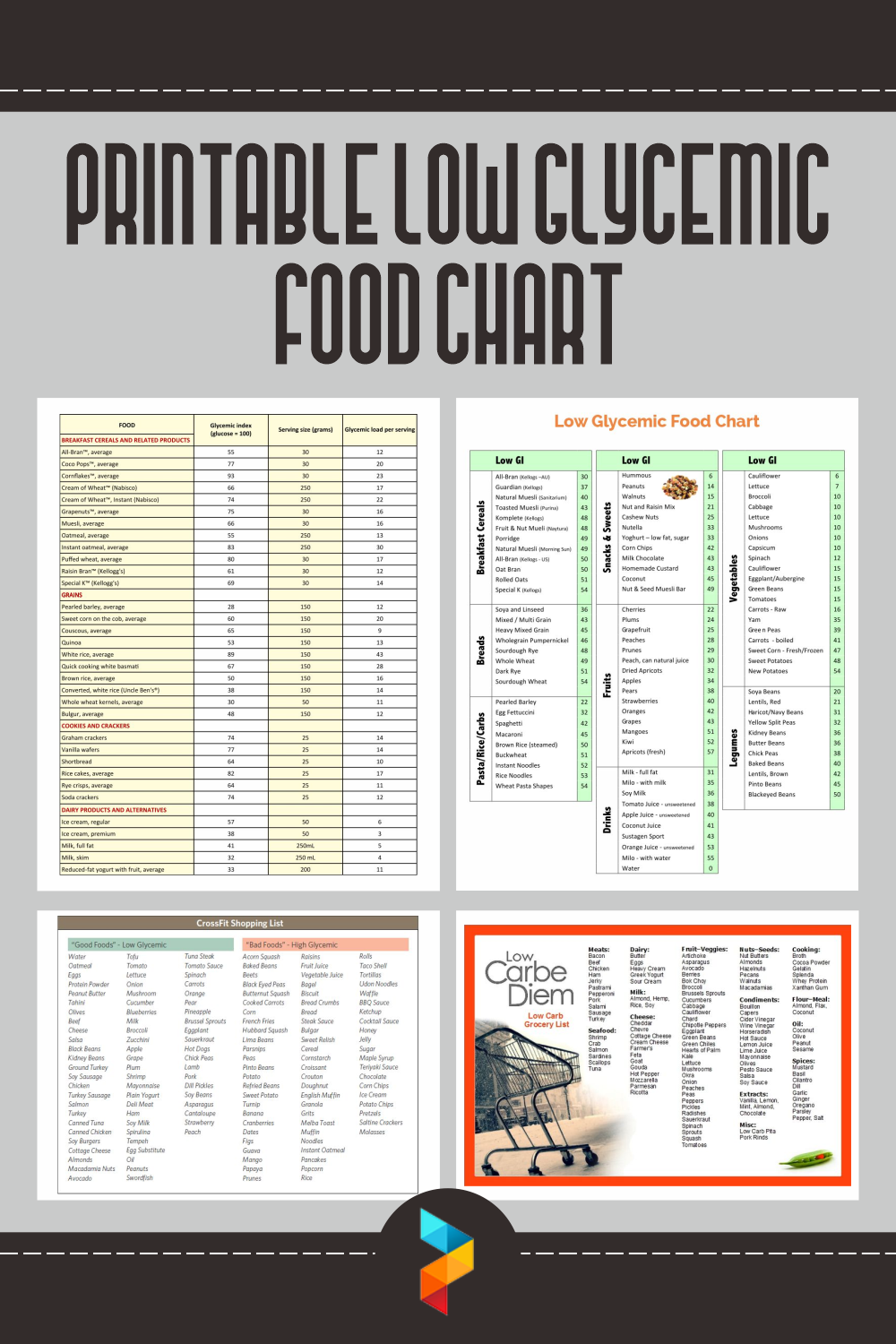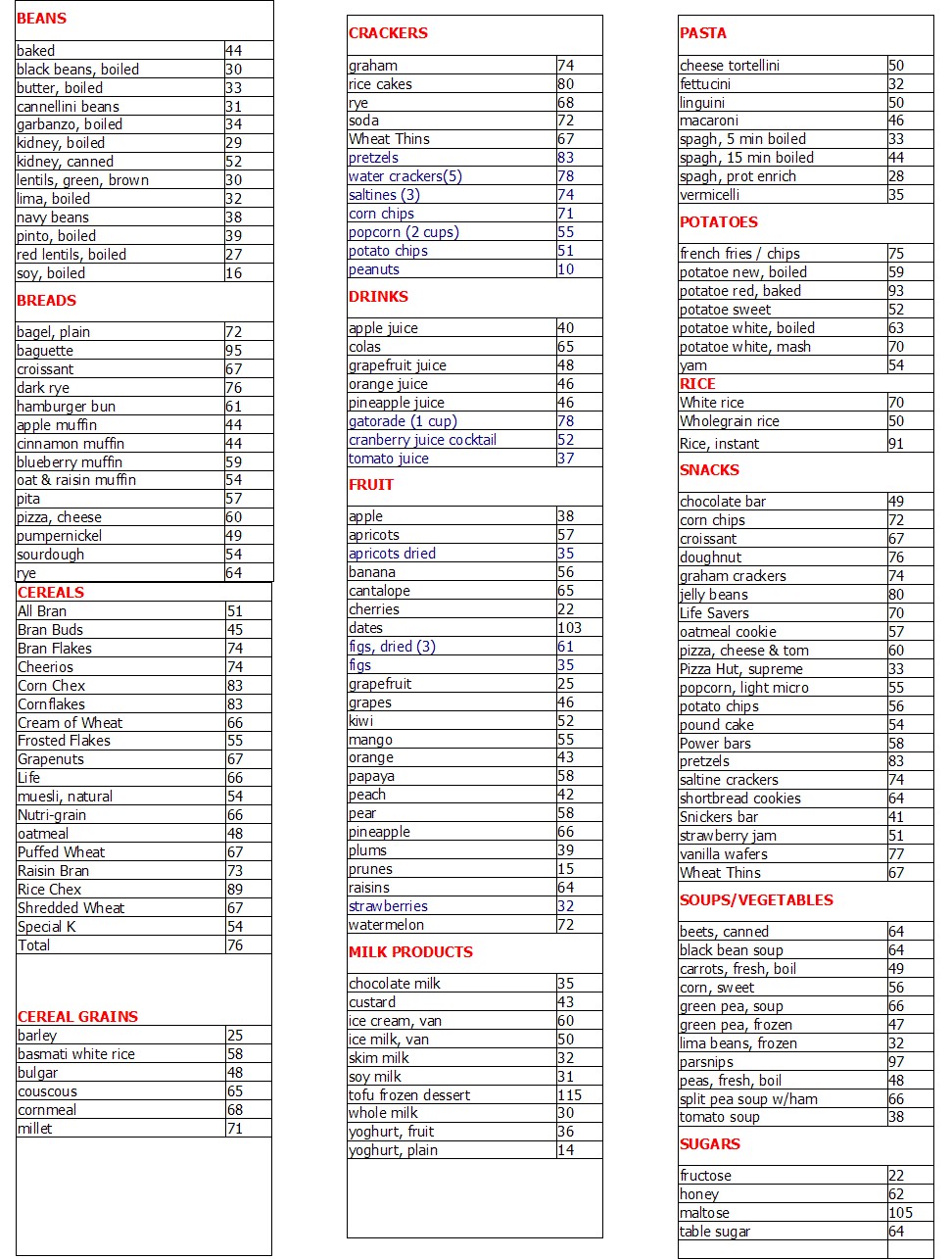Glycemic Index Chart Printable
Glycemic Index Chart Printable - 56 to 69 high gi: Glycemic index chart high glycemic foods result in a quick spike in insulin and blood sugar (also known as blood glucose). The gl of a food is calculated by multiplying the gi of that food by the amount of carbohydrate in an actual serving of the food. The glycemic index charts below lists common foods followed by their serving size and glycemic index number, according to the gi database compiled by the university of sydney and cited by the usda. The glycemic (glycaemic) index ( gi; <11 dates, dried 103 2 oz 40 42 cornflakes 81 1 cup 26 21 jelly beans 78 1 oz 28 22 puffed rice cakes 78 3 cakes 21 17 Foods low on the glycemic index (gi) scale tend to release glucose slowly and steadily. The majority of our glycemic index values are taken from the international tables of glycemic index values. The glycemic index is a value assigned to foods based on how quickly and how high those foods cause increases in blood glucose levels. Low glycemic foods have a slower, smaller effect. Web the glycemic index is a system of ranking foods on a scale of 0 to 100 according to how high blood glucose peaks within two hours of consuming the specific food. 70 to 100 the following charts highlight low, medium, and high gi foods based on data from the american diabetes association. The gl of a food is calculated. Low glycemic foods have a slower, smaller effect. Web the glycemic index (gi) chart for carbohydrates fruits: Web by mayo clinic staff. 56 to 69 high gi: Web the glycemic index (gi) is a measure of how fast a food raises the blood sugar level. Eating foods with a lower gi may result in a more gradual rise in your blood sugar level. The majority of our glycemic index values are taken from the international tables of glycemic index values. The glycemic index ranks food on a scale from 0 to 100. Web glycemic index (gi) & glycemic load (gl) values food glycemic index (glucose=100). Eating foods with a lower gi may result in a more gradual rise in your blood sugar level. The glycemic index ranks food on a scale from 0 to 100. Glycemic index and glycemic load for 100+ foods: Glycemic index chart high glycemic foods result in a quick spike in insulin and blood sugar (also known as blood glucose). The. 20 or above is considered high. A low gi is a sign of better quality. Web glycemic index (gi) is a ranking system that measures how quickly carbohydrates in a food are broken down and absorbed into the bloodstream, causing a rise in blood sugar levels. Foods low on the glycemic index (gi) scale tend to release glucose slowly and. Web the glycemic load is determined by multiplying the grams of a carbohydrate in a serving by the glycemic index, then dividing by 100. Glycemic index chart high glycemic foods result in a quick spike in insulin and blood sugar (also known as blood glucose). Cheat sheet for diabetes factors affecting the gi of a food other general gl and. Watermelon, for example, has a high glycemic index (80). Web the glycemic load is determined by multiplying the grams of a carbohydrate in a serving by the glycemic index, then dividing by 100. The glycemic (glycaemic) index ( gi; A low gi is a sign of better quality. Web glycemic index (gi) is a ranking system that measures how quickly. / ɡlaɪˈsiːmɪk / [1]) is a number from 0 to 100 assigned to a food, with pure glucose arbitrarily given the value of 100, which represents the relative rise in the blood glucose level two hours after consuming that food. Foods low on the glycemic index (gi) scale tend to release glucose slowly and steadily. The gl of a food. How glycemic index is measured glycemic index values were developed by a rigorous testing process using 10 or more people for each food. A low gi is a sign of better quality. The gl of a food is calculated by multiplying the gi of that food by the amount of carbohydrate in an actual serving of the food. The food. Talk with your dietitian about whether this method might work for you. Cheat sheet for diabetes factors affecting the gi of a food other general gl and gi diet guidelines What is the glycemic index? Low glycemic foods have a slower, smaller effect. Some people who live with diabetes use the glycemic index to select foods, especially carbohydrates. Cheat sheet for diabetes factors affecting the gi of a food other general gl and gi diet guidelines Others have been taken from smaller studies, researching specific foods. Watermelon, for example, has a high glycemic index (80). Web the glycemic index, or gi, uses a scale of numbers from 1 to 100 to rank carbohydrate foods by how quickly a serving size of each raises blood sugar. Effect of macronutrients and fiber on postprandial glycemic responses and meal glycemic index and glycemic load value determinations. Web low glycemic index (55 or less) choose most often medium glycemic index (56 to 69) choose less often high glycemic index (70 or more) choose least often baked beans chickpeas kidney beans lentils mung beans romano beans soybeans/edamame split peas additional foods: Graph depicting blood sugar change during a day with three meals. Some people who live with diabetes use the glycemic index to select foods, especially carbohydrates. Web the glycemic index (gi) chart for carbohydrates fruits: <11 dates, dried 103 2 oz 40 42 cornflakes 81 1 cup 26 21 jelly beans 78 1 oz 28 22 puffed rice cakes 78 3 cakes 21 17 Web a gl below 10 is considered “low”, from 11 to 19 “moderate”, and above 20 is “high” (see table 1). The food insulin index (fii) A glycemic load of 10 or below is considered low; The glycemic index ranks food on a scale from 0 to 100. The glycemic index is about the quality of the carbohydrates, not the quantity. Foods low on the glycemic index (gi) scale tend to release glucose slowly and steadily. Eating foods with a lower gi may result in a more gradual rise in your blood sugar level. Web the glycemic index (gi) is a measure of how fast a food raises the blood sugar level. Web by mayo clinic staff. 70 to 100 the following charts highlight low, medium, and high gi foods based on data from the american diabetes association. Web glycemic index (gi) & glycemic load (gl) values food glycemic index (glucose=100) serving size carbohydrate per serving (g) glycemic load per serving high: Web the glycemic load is determined by multiplying the grams of a carbohydrate in a serving by the glycemic index, then dividing by 100. Some people who live with diabetes use the glycemic index to select foods, especially carbohydrates. Web november 16, 2021. The glycemic index is a value assigned to foods based on how quickly and how high those foods cause increases in blood glucose levels. A glycemic load of 10 or below is considered low; 20 or above is considered high. Low glycemic foods have a slower, smaller effect. Glycemic index chart high glycemic foods result in a quick spike in insulin and blood sugar (also known as blood glucose). Others have been taken from smaller studies, researching specific foods. It is a sign of the quality of carbohydrates in the food. Web glycemic index and glycemic load chart for diabetics simple glycemic index and glycemic load guide for diabetes in this article: The majority of our glycemic index values are taken from the international tables of glycemic index values. The food insulin index (fii) Because carbohydrates, or carbs, such as rice, pasta, bread, and fruit, raise blood sugar more, and more quickly, than fats or proteins do. A low gi is a sign of better quality.10 Best GI Of Food Chart Printable
Printable Glycemic Index Chart, Image Search Glycemic index, Glycemic
10 Best Printable Low Glycemic Food Chart
Glycemic Index Glycemic Load GIGL Food Chart
Alfa img Showing > Glycemic Index Chart PDF Low glycemic index
glycemic index chart TOP GOAL
Prince William glycemic index table
Glycemic Index And Load Tables
Pdf Glycemic Index Food List Chart Resume Examples
78 best GYLCEMIC INDEX images on Pinterest Healthy meals, Cooking
Web The Glycemic Index, Or Gi, Uses A Scale Of Numbers From 1 To 100 To Rank Carbohydrate Foods By How Quickly A Serving Size Of Each Raises Blood Sugar.
Web Glycemic Index And Printable Food Chart Nutrition Articles Learning Protein Carbohydrates Fats Vitamins Minerals Fruits Water Vegetables Organic Glycemic Index Fiber Gluten Cholesterol Supplements Probiotics Triglycerides Diuretics Sweeteners Cortisol Salba Mung Beans Hemp Seeds Quinoa Wild Pacific Salmon Whey Protein Egg Whites.
The Low End Of The Scale Has Foods That Have Little Effect On Blood Sugar Levels.
/ Ɡlaɪˈsiːmɪk / [1]) Is A Number From 0 To 100 Assigned To A Food, With Pure Glucose Arbitrarily Given The Value Of 100, Which Represents The Relative Rise In The Blood Glucose Level Two Hours After Consuming That Food.
Related Post:








